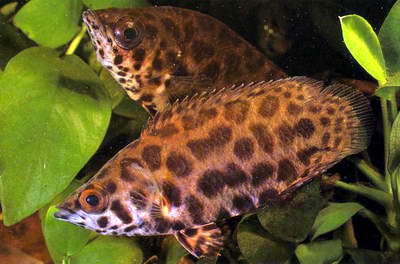Ctenopoma Acutirostre
Labyrinth fish from Asia are very familiar to most aquarists. Gouramis like Trichogaster and Colisa grace thousands of tanks. The Siamese Fighting Fish (Betta splendens) is a world-wide favorite. Even the Paradise Fish (Macropodus opercularis)
has a loyal following. Far less commonly kept are the African genera
of anabantoids. These include the so-called 'bushfish' of the genera Ctenopoma, Microctenopoma and Sandelia.
One characteristic common to all labyrinth fish is the presence of a specialized respiratory structure called the 'labyrinth' organ. This is an auxiliary breathing apparatus that allows labyrinth fish to utilize atmospheric air when the dissolved oxygen content of the surrounding water gets too low. Labyrinth fish utilize this organ to greater or lesser degrees, depending on the type of fish. Regardless of type, most labyrinth fish can occasionally be seen at the surface gulping air even if the dissolved oxygen content of the water is high. Labyrinth fish are often the last fish to die in ponds that dry out during periods of drought.
One characteristic common to all labyrinth fish is the presence of a specialized respiratory structure called the 'labyrinth' organ. This is an auxiliary breathing apparatus that allows labyrinth fish to utilize atmospheric air when the dissolved oxygen content of the surrounding water gets too low. Labyrinth fish utilize this organ to greater or lesser degrees, depending on the type of fish. Regardless of type, most labyrinth fish can occasionally be seen at the surface gulping air even if the dissolved oxygen content of the water is high. Labyrinth fish are often the last fish to die in ponds that dry out during periods of drought.








This comment has been removed by the author.
ReplyDelete